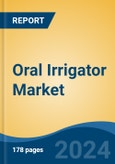Speak directly to the analyst to clarify any post sales queries you may have.
10% Free customizationThis report comes with 10% free customization, enabling you to add data that meets your specific business needs.
As per the World Dental Federation (FDI) 2021 report, periodontal diseases can potentially affect up to 50% of the adult population worldwide. Moreover, more than 530 million children suffer from tooth decay problems in their primary teeth across the globe. Thus, an increase in the occurrence of periodontal disease and tooth decay problems among the global population positively impacts the market for oral irrigators.
Key Market Drivers
Increased Emphasis on Oral Health
In recent years, the world has witnessed a profound shift in the way individuals perceive and prioritize their oral health. This shift is more than just a fleeting trend; it has significant implications for the healthcare industry, particularly in the field of dental care. Among the products benefiting from this transformation is the global oral irrigator market. The cornerstone of the oral health revolution is heightened awareness.People are now more informed about the crucial connection between good oral hygiene and overall health. Research has shown that poor oral health can contribute to a range of systemic health issues, including heart disease, diabetes, and respiratory problems. As this knowledge becomes more widespread, individuals are increasingly motivated to invest in effective oral care tools and practices. This, in turn, has led to a surge in the demand for oral irrigators.
Key Market Challenges
Competition from Traditional Dental Care Products
One of the major challenges faced by the oral irrigator market is competition from established and traditional dental care products. Dental floss, interdental brushes, and other traditional methods for oral hygiene have been around for a long time and have a loyal user base. Convincing individuals to switch from familiar methods to oral irrigators can be a formidable challenge.Key Market Trends
Smart Oral Irrigators
The convergence of oral health and technology is giving rise to smart oral irrigators. These next-generation devices are equipped with Bluetooth connectivity, smartphone apps, and other intelligent features. Users can now monitor their oral health, track their flossing routines, and receive real-time feedback and reminders on their mobile devices. Smart oral irrigators are set to enhance user engagement, making oral care more interactive and tailored to individual needs.Key Market Players
- Colgate-Palmolive Co
- Procter & Gamble
- Church & Dwight Co., Inc.
- GSK plc.
- Johnson & Johnson Services, Inc.
- Lion Corporation
- Sunstar Suisse S.A.
- Dr Fresh LLC
- Dentaid S.L.
- Koninklijke Philips N.V.
Report Scope:
In this report, the Global Oral Irrigator Market has been segmented into the following categories, in addition to the industry trends which have also been detailed below:Oral Irrigator Market, By Product Type:
- Countertop
- Cordless
Oral Irrigator Market, By Application:
- Home
- Dentistry
Oral Irrigator Market, By Distribution Channel:
- Online
- Offline
Oral Irrigator Market, By Region:
- North America
- United States
- Canada
- Mexico
- Europe
- Germany
- United Kingdom
- France
- Italy
- Spain
- Asia-Pacific
- China
- Japan
- India
- Australia
- South Korea
- South America
- Brazil
- Argentina
- Colombia
- Middle East & Africa
- South Africa
- Saudi Arabia
- UAE
- Kuwait
Competitive Landscape
Company Profiles: Detailed analysis of the major companies present in the Global Oral Irrigator Market.Available Customizations:
With the given market data, the publisher offers customizations according to a company's specific needs. The following customization options are available for the report.Company Information
- Detailed analysis and profiling of additional market players (up to five).
This product will be delivered within 1-3 business days.
Table of Contents
Companies Mentioned
- Colgate-Palmolive Co
- Procter & Gamble
- Church & Dwight Co., Inc.
- GSK plc.
- Johnson & Johnson Services, Inc.
- Lion Corporation
- Sunstar Suisse S.A.
- Dr Fresh LLC
- Dentaid S.L.
- Koninklijke Philips N.V.
Table Information
| Report Attribute | Details |
|---|---|
| No. of Pages | 180 |
| Published | March 2025 |
| Forecast Period | 2024 - 2030 |
| Estimated Market Value ( USD | $ 1.24 Billion |
| Forecasted Market Value ( USD | $ 1.67 Billion |
| Compound Annual Growth Rate | 5.0% |
| Regions Covered | Global |
| No. of Companies Mentioned | 10 |









